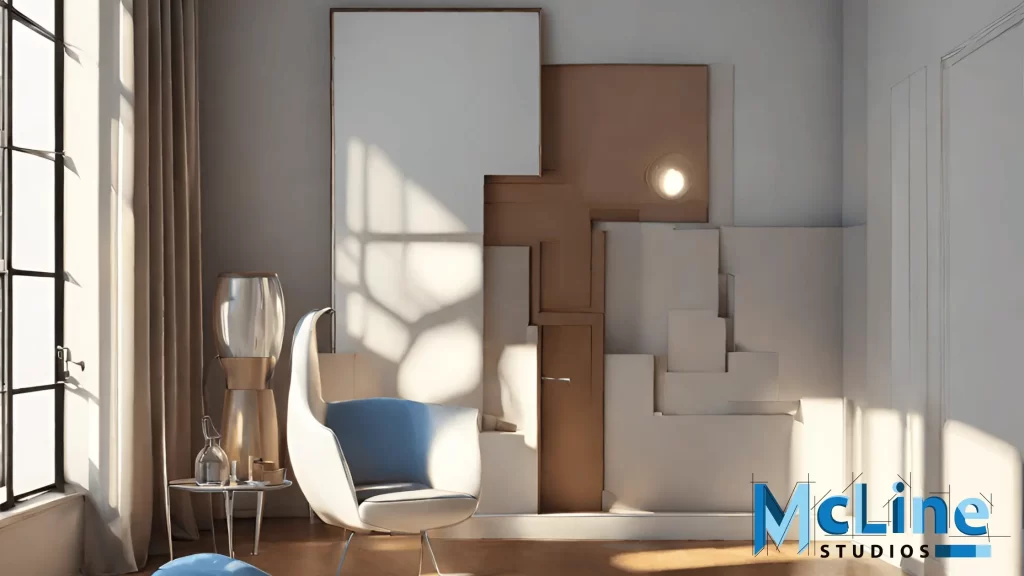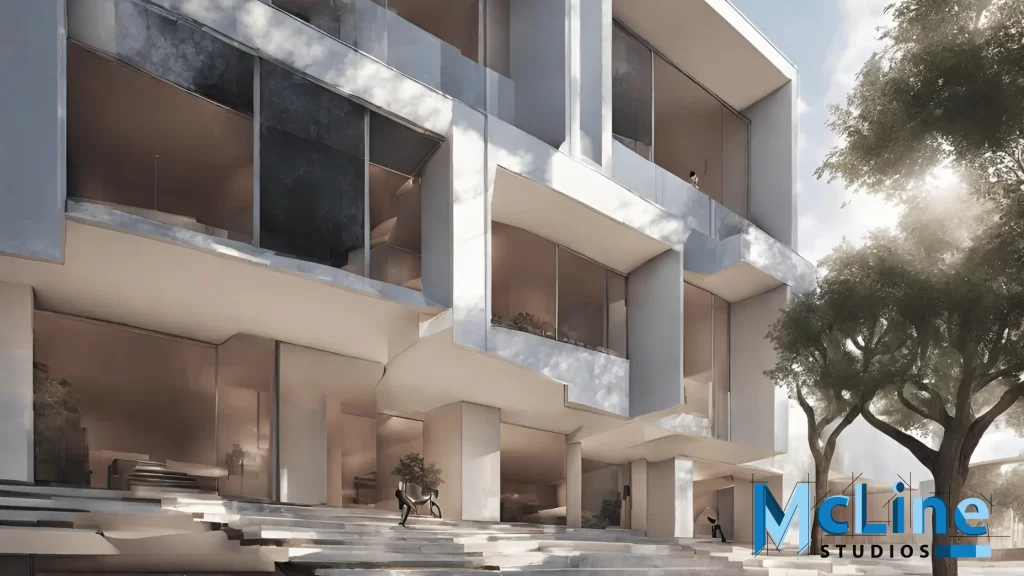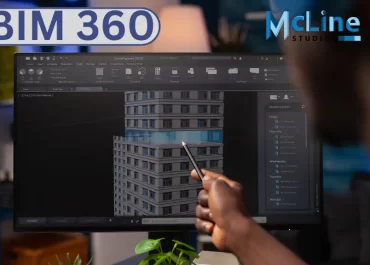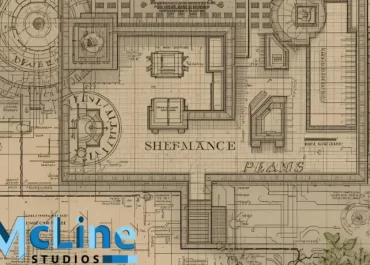Ray tracing, a rendering technique rooted in simulating the behavior of light, has emerged as a cornerstone in architectural visualization. This method meticulously traces the path of light rays as they interact with virtual environments, producing images with unparalleled realism.
Architects leverage ray tracing to generate lifelike visualizations that accurately portray how natural light illuminates and interacts with architectural spaces.
By simulating the physics of light, ray tracing enables the creation of photorealistic images, showcasing intricate details like shadows, reflections, and refractions. This level of precision empowers architects to convey their designs convincingly, aiding in client presentations, project evaluations, and marketing materials.

What is Ray Tracing?
Ray tracing is a rendering technique that simulates the way light interacts with objects in a virtual environment. It traces the path of light rays as they travel through the scene, calculating their interactions with surfaces to generate highly realistic images. This process mimics the behavior of light in the real world, producing intricate shadows, reflections, and refractions.
Components of Ray Tracing
- 2D Ray Tracing: At its core, ray tracing involves the creation and manipulation of ray, lines extending from the virtual camera into the scene. In 2D ray tracing, these rays are projected onto a flat plane, determining the colors of pixels based on the interactions with objects in the scene. This technique forms the foundation for more advanced 3D ray tracing.
- 3D Ray Tracing: As the natural progression from 2D ray tracing, 3D ray tracing rendering expands into the third dimension, considering the depth and spatial relationships between objects. This extension enhances the realism of the rendered images, capturing the nuances of light as it interacts with the various surfaces and materials within the architectural environment.
Benefits of Ray Tracing Rendering
Ray tracing stimulates the way light interacts with objects in a virtual environment. Here are some of the key benefits of ray tracing:
- Realistic Lighting and Shadows: Ray tracing accurately simulates the behavior of light, leading to realistic lighting effects and shadows. This includes soft shadows, reflections, and refractions, creating a more immersive and lifelike visual experience.
- Global Illumination: Ray tracing can simulate global illumination, which means that light bounces off surfaces and contributes to the overall lighting in a scene. This results in more natural and realistic lighting conditions.
- Reflections and Refractions: Ray tracing allows for accurate reflections and refractions, enhancing the realism of materials like glass and water. This is particularly important for creating lifelike scenes in computer graphics.
- Improved Materials and Textures: Ray tracing enables a more accurate representation of material properties, such as metallic surfaces, roughness, and subsurface scattering. This contributes to a higher level of detail and realism in rendered images.
- Consistent Lighting: Ray tracing helps maintain consistent lighting across different surfaces and angles, reducing the need for artists to manually adjust lighting parameters. This can streamline the content creation process in computer graphics.
- Realistic Depth of Field: Ray tracing can simulate realistic depth of field effects, allowing for more convincing focus and blur in images. This enhances the perception of depth and helps draw attention to specific elements in a scene.
- Accurate Soft Shadows: Ray tracing produces soft shadows with smooth transitions, which more closely resemble the way shadows appear in the real world. This contributes to a more natural and visually pleasing result.
- Cinematic Rendering: Ray tracing is widely used in the film and animation industry to achieve cinematic-quality visuals. It allows for the creation of high-fidelity scenes with lifelike lighting and reflections.
Use of Ray Tracing in Architectural Visualization
1. Realistic Lighting and Shadows: One of the key advantages of ray tracing in architectural visualization is its ability to accurately simulate lighting conditions. Unlike traditional rendering techniques, ray tracing produces soft shadows, global illumination, and realistic reflections, contributing to a more immersive and believable representation of architectural spaces.
2. Material Realism: Ray tracing excels in capturing the intricate details of materials, from the reflective sheen of polished surfaces to the translucency of glass. This level of detail enhances the visual appeal of architectural renderings, allowing stakeholders to visualize the finished project with a high degree of accuracy.
3. Enhanced Reflections and Refractions: Architectural structures often involve materials with reflective and refractive properties. Ray tracing excels in accurately depicting reflections on surfaces like water or glass facades, as well as the bending of light as it passes through transparent materials. This capability contributes to a more lifelike representation of architectural designs.
4. Immersive Environments: By incorporating ray tracing into architectural visualization, designers and clients alike can explore virtual environments that closely resemble the final product. This not only aids in decision-making but also facilitates a more immersive and engaging experience during the design review process.
Why Ray Tracing is the Future of Architectural Visualization

The integration of ray tracing into architectural visualization has given rise to specialized services aimed at harnessing the full potential of this technology. Ray tracing service providers like McLine Studios provide architects, designers, and developers with the expertise needed to create stunning and realistic renderings.
Ray tracing services offer a level of precision that goes beyond traditional rendering methods. Architects can visualize their designs with unparalleled accuracy, ensuring that every detail is faithfully represented in the virtual space.
While the computational demands of ray tracing are substantial, ray tracing services leverage advanced hardware and software solutions to optimize rendering times. This efficiency allows architects to iterate quickly, making adjustments to designs and visualizing the impact in near-real-time.
The realistic renderings produced through ray tracing services serve as powerful communication tools. Stakeholders, including clients and project teams, can easily understand and engage with the design, fostering effective collaboration and decision-making.
Interpretation
As technology continues to advance, the integration of ray tracing in architectural visualization is poised to become increasingly prevalent. The demand for realism and the need to communicate complex designs effectively will drive further innovations in this field.
Ray tracing has emerged as a game-changer in architectural visualization, offering unparalleled realism and detail. From 2D ray tracing to the immersive experiences enabled by 3D ray tracing rendering, this technology has transformed the way architects and designers bring their visions to life.
With a focus on realism, precision, and efficiency, Mcline Studios is not just a service provider but a visionary partner in transforming architectural visions into awe-inspiring realities. As we look ahead, the collaboration between architects and Mcline Studios promises to shape a future where architectural visualizations are not just representations but immersive experiences that captivate and inspire.




